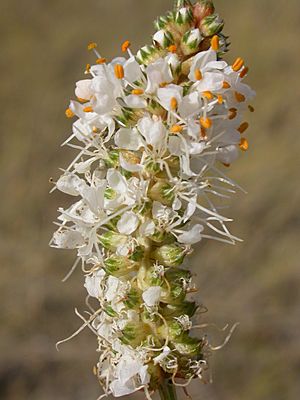White prairie clover facts for kids
Quick facts for kids White prairie clover |
|
|---|---|
 |
|
| Conservation status | |
| Scientific classification | |
| Kingdom: | |
| (unranked): | |
| (unranked): | |
| (unranked): | |
| Order: | |
| Family: | |
| Genus: |
Dalea
|
| Species: |
D. candida
|
| Binomial name | |
| Dalea candida Michx. ex Willd.
|
|
| Varieties | |
|
|
The white prairie clover (scientific name: Dalea candida) is a beautiful flowering plant. It belongs to the legume family, which includes peas and beans. This plant is native to North America.
You can find it growing across central Canada, the central United States, and northern Mexico. Sometimes, it might even pop up in new places where it wasn't originally found. It likes to grow in many different areas. These include prairie grasslands, hills, woods, forests, and even places where the ground has been disturbed.
About the White Prairie Clover
This plant is a perennial herb, meaning it lives for many years. It grows straight up to about 1 meter (3 feet) tall. It has a long main root, called a taproot, which can go down 1.5 to 1.8 meters (5 or 6 feet) into the ground.
Its leaves grow in a zig-zag pattern along the stem. Each leaf is made up of several small, thin, light green parts called leaflets. These leaflets have tiny dots on them.
The flowers of the white prairie clover grow in a tight, cylinder-shaped cluster. This cluster is found at the tip of each stem or branch. The cluster is full of pointed green parts called calyces. The flowers at the bottom of the cluster have white petals and bloom first. The flowers higher up bloom later. After the flowers, the plant makes a small, green, oval-shaped legume pod. This pod is a type of fruit and usually holds one seed.
A famous explorer named Meriwether Lewis collected a sample of this plant in Nebraska in 1804.
How People Use It
Some Native American groups have traditionally used this plant. For example, the Ramah Navajo people used the candida type of this plant. They used it to help with stomachaches and fevers. They even called it a "life medicine." They also made a special tea from it to help sheep that were sick.
White Prairie Clover in Nature
The white prairie clover is very popular with pollinators like butterflies and bees. They love to visit its flowers.
Because it is a legume, this plant is also a "nitrogen fixer." This means it helps make the soil healthier by adding important nutrients like nitrogen.
It is also a special plant for certain butterflies. Their caterpillars eat its leaves. These butterflies include the clouded sulphur, marine blue, Reakirt's blue, and southern dogface.
See also
 In Spanish: Dalea candida para niños
In Spanish: Dalea candida para niños


